2.10.1 General
Within the framework of the agreement between Luka and TÜV Rheinland Nederland B.V. the checking of the manufacturing and assembly quality by TÜV Rheinland Nederland B.V. is guaranteed. Safety, health and the environment are also important issues in assembly work. In accordance with the Working Conditions Act and the VCA checklist, the various parties on the construction site have their own specific responsibilities. For example, the main contractor has final responsibility for safety on the project and the provision of general facilities and safety equipment. As a subcontractor, the Luka members have, among other things, the responsibility for the correct actions of their employees and for providing them with the right resources. Usually all this is laid down in
a project plan. If required and possibly in consultation with the client, the Luka members will provide an in-house project plan. This plan serves as part of the total project plan provided by the main contractor.
2.10.2 Transport and storage
The transport of air ducts must take place in a responsible way, so that transport damage is prevented. It is recommended to use boxes, net bags, bundles, crates or containers for transport of circular fittings. Air ducts are sensitive to deformation by careless or rough handling. Careful unloading is therefore a necessity. Damage to the connection profiles on rectangular ducts and at the edges of circular ducts increases the risk of air leakage. In order to prevent damage as much as possible, it is recommended that deliveries to the construction site are closely coordinated with the progress of assembly.
Damages will be treated as follows:
- scratches which have led to localised removal of the zinc layer are treatedon site with an anti-corrosion zinc dust paint;
- dents in the duct, which reduce the flow shall be fixed locally so that thefree flow of the duct is guaranteed at least 95 %;
- damaged connections are repaired in such a way that the required structural strength and airtightness in accordance with this performance specification can be ensured.
If no description is given in the specifications (see 2.12), storage on the construction site can take place in the open air or in the building shell. In both cases the ducts must be stored on a dry surface. When stored in the open air, the ducts must be protected against extreme weather conditions and pollution. After delivery to the construction site, the air ducts and fittings should be stored as close to the installation site as possible by crane or hoist.
2.10.3 Mounting instructions for rectangular and circular air ducts
At the start of each assembly, the assembly supervisor must be in possession of assembly drawings and/or material lists. The assembly supervisor must also explain the content of the assembly instructions and the specific regulations applicable to the construction site.
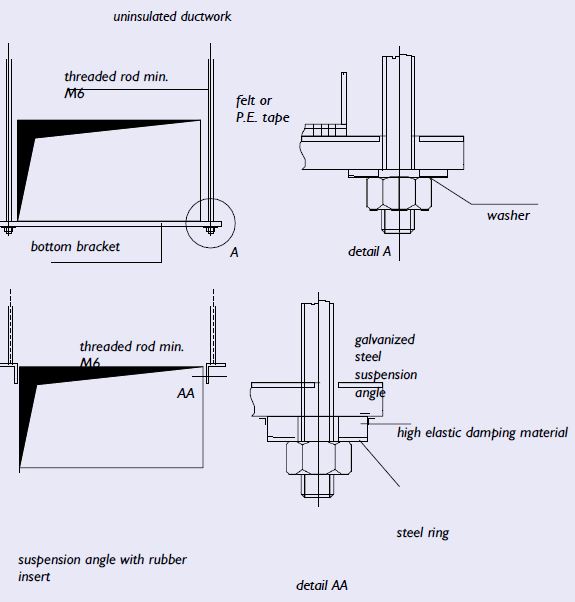
2.10.3.1 Suspension and support of uninsulated rectangular metal ducts
The air ducts are fixed or suspended in such a way that the duct parts with fittings form a stable and tight whole. The choice of materials and construction takes into account the environmental conditions and the linear expansion of the duct material.
The most common constructions are:
- Consoles, galvanized or at least coated with zinc dust, which are used for fixing against a building structure;
- Suspension structures, which are of such strength that the total weight ofthe air ducts, including the intermediate fittings, is transferred to thestructural suspension points by threaded rods;
- duct corners with rubber insert.
The suspension must consist of a lower bracket of Sendzimir galvanised material, provided with felt or P.E. tape with minimum dimensions of 18 x 4 mm, with threaded rods minimum M6, directly along the duct. The distance between these threaded rods and the duct wall is maximum 50 and minimum 15 mm. The brackets, with a mutual distance of 3 metres maximum centre-to-centre, can be executed in a profile form, or in a standard commercial profile of sufficient strength, so that sufficient stiffness is obtained. See table below.
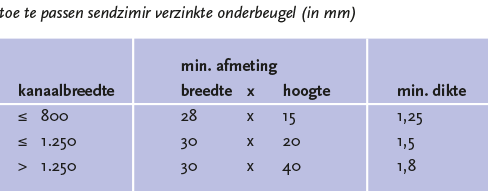
2.10.3.2 Suspension and support of shaft ducts
For shaft ducts, consoles can be used against the wall or profiles can be attached to the ducts and supported on the floor. The steel constructions will be provided with at least an anti-corrosion finish.
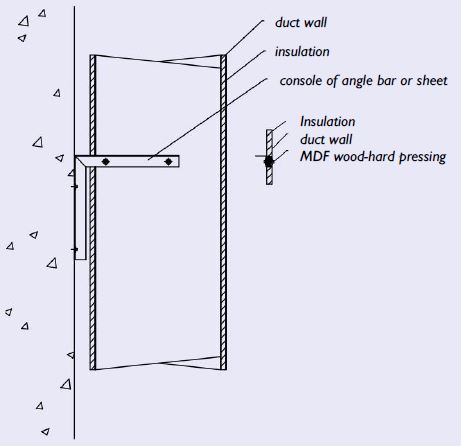
2.10.3.3 Suspension and support for post-insolation of ducts
If the ductwork is insulated externally after installation, MDF spacer blocks 50 x 50 x 25 or hard pressed insulation strips 100 x 25 mm must be fitted between the bottom bracket and the duct.
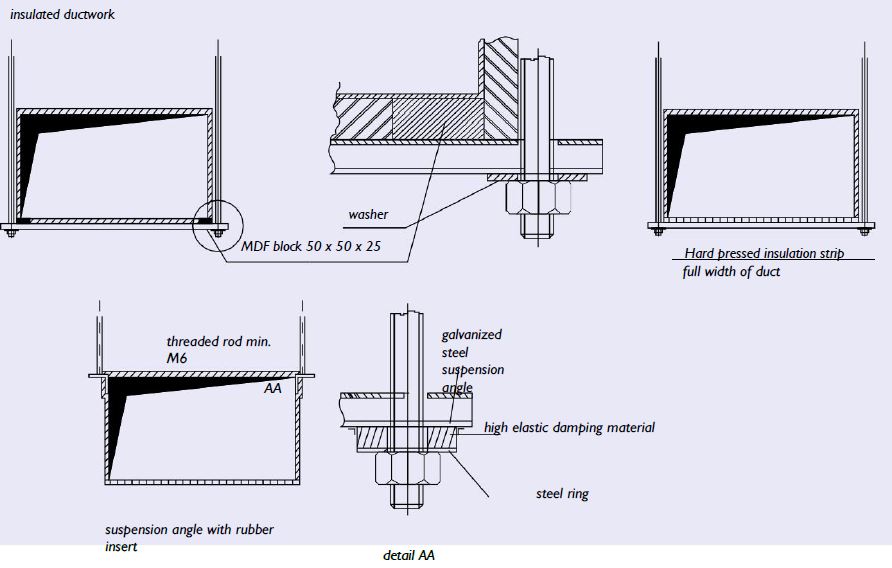
2.10.3.4 Suspension and support of circular metal ducts
Circular air ducts are fixed or suspended in such a way that the duct parts and fittings form a stable and tight whole. The choice of materials and construction takes into account the environmental conditions and the
linear expansion of the duct material. The most common constructions are:
- consoles, galvanized or at least coated with zinc dust, which areused for fixing against a building structure;
- Suspension structures which are of such strength that the total weight ofthe air ducts, including the intermediate fittings, is transferred to thestructural suspension points by threaded rods;
The brackets for pipes with a diameter of > 450 mm must be designed as two-point suspension with an upper and lower bracket. Felt or P.E. tape with minimum dimensions of 18 x 4 mm should be applied. For smaller diameters it is sufficient to use one-point brackets made of Sendzimir-galvanised steel tape or mesh tape, provided with felt or P.E. tape with the minimum dimension of 18 x 4 mm, or plastic coated mesh tape with one-point suspension. Standard brackets with rubber insert can also be used. The maximum centre-to-centre distance of the brackets can be up to 3 metres. For shafts, consoles can be used against the wall, or profiles on the shafts, which are supported on the floor. The steel constructions will be made anti-corrosive.
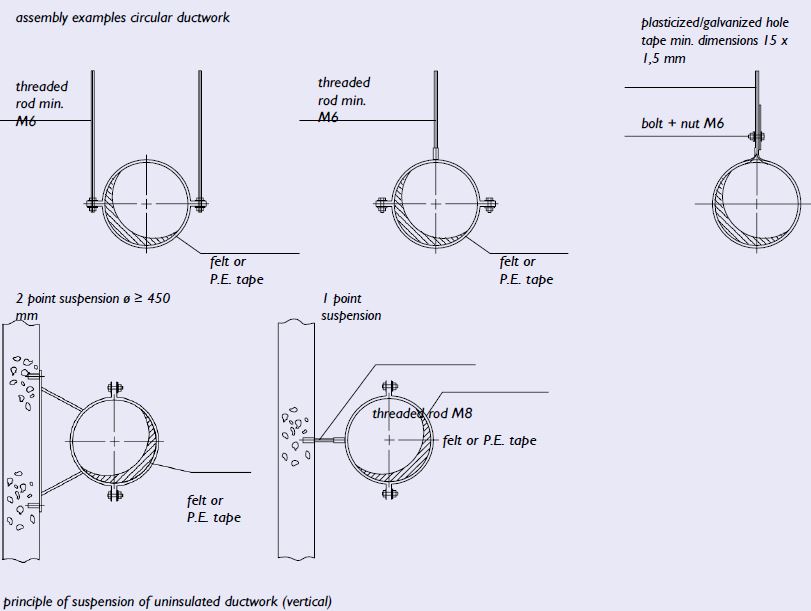
2.10.3.5 Suspension and support of rectangular plastic, mineral wool and hard foam ducts.
Rectangular ducts are fixed or suspended so that the ducts and fittings form a stable and tight unit. The choice of materials and construction, the environmental conditions and the linear expansion of the duct material are taken into account. The most common constructions are:
- Consoles, galvanized or at least coated with zinc dust, which are used for fixing against a building structure;
- Suspension structures, which are of such strength that the total weight ofthe air ducts, including the intermediate fittings, is transferred to thestructural suspension points by threaded rods.
Suspension is by means of a top and bottom bracket with threaded rods minimum M6, directly along the duct. The distance between these threaded rods and the duct wall is maximum 50 and minimum 15 mm. The brackets, with a mutual distance of maximum 3 metres centre-to-centre, must be executed in profile form, or in a standard commercial profile of sufficient strength, so that sufficient stiffness is obtained. See table below.
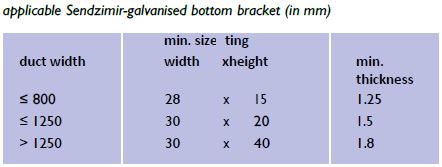
Roof ducts support, by means of weather resistant support profiles, the roof facilities installed by the building contractor. These support profiles are a maximum of 2.5 metres centred on each other lengthwise.
2.10.3.6 Suspension and support of circular plastic ducts
These air ducts are fixed or suspended in such a way that the duct parts with fittings form a stable and tight whole. The choice of materials and construction takes into account the surrounding conditions and the linear expansion of the duct material.
2.10.3.7 Support roof ducts
Roof ducts support, by means of weather resistant support profiles, the roof facilities installed by the building contractor. These support profiles are a maximum of 2.5 metres centred on each other lengthwise.
Open-ended roof ducts (intake and exhaust ventilation ducts) must be anchored to a third-party construction that is part of the overall roof structure to prevent storm damage.
2.10.4 Suspension of air ducts and fittings with flexible suspension systems.
Flexible suspension systems are also used in addition to suspension and mounting with threaded rods. Unlike threaded rod suspension and assembly, the threaded rod is replaced by a flexible suspension medium such as steel cable or band, and the bolt / nut fixing and securing are replaced by a clamping device. Reasons for applying these suspension systems are mostly aesthetics, faster suspension and adaptability.
Luka recommends to check the equivalence of flexible suspension systems for air ducts and fittings with the above described suspension with threaded rods on the following elements:
- Fire resistance of suspension material;
- Bearing capacity of suspension material;
- Molest risk of suspension material;
- Durable securing of clamping device;
- Risk of damage and deformation of air ducts, fittings and insulation.

